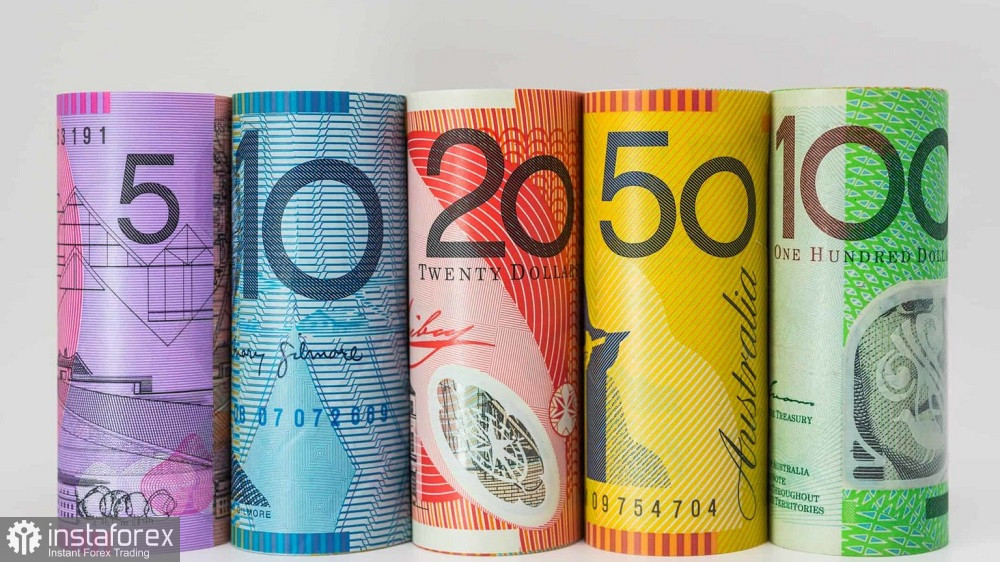The AUD/USD currency pair is trying to develop a corrective rise this week, but buyers' actions look unconvincing. On the one hand, the pair is indeed showing an upward trend, having updated almost a 10-month price low (0.6368). On the other hand, the daily candles on the AUD/USD chart are "empty": sellers reclaim almost all lost positions within the day. Because of this notorious "almost," the pair slowly creeps up, creating an illusion of a corrective pullback. Overall, the established fundamental background does not contribute to the development of an upward movement. But on the eve of the economic symposium in Jackson Hole, which kicks off tomorrow, August 24th, traders are clearly nervous and hesitant to make major price moves.

During the Asian trading session on Wednesday, secondary macroeconomic releases were published in Australia, reflecting quite negative trends. In particular, the S&P Global Manufacturing PMI for August fell to 49.4 points (with the July figure being 49.6). The Service Sector PMI for the same period plummeted to 46.7 points (with a forecast decline to 47.9). In this case, the indicator has been consistently declining for the fourth consecutive month, and the August result is the weakest since February 2022.
The disappointing PMI data extinguished another upward impulse for the AUD/USD pair, but bears could not fully capitalize on the situation as the greenback is also under background pressure.
The main problem with the U.S. currency is the uncertainty of dollar bulls regarding the prospects for further monetary policy tightening by the U.S. Federal Reserve. According to the CME FedWatch Tool, the probability of a 25 basis point rate hike following the September meeting is currently only 13%. Traders were not convinced by conflicting inflation releases (acceleration of the overall Consumer Price Index, growth in the Producer Price Index, wage growth), strong retail sales, growth in industrial production in the States, or robust U.S. GDP growth in the second quarter. Traders still don't believe in a September rate hike, although recent releases do allow for the realization of this scenario.
Doubts about September's prospects for monetary policy tightening were also recently voiced by economists surveyed by Reuters. This circumstance intensified the background pressure on the U.S. currency, which for some time (after the publication of inflation reports) was in a kind of "euphoria." But the surveyed currency strategists brought dollar bulls back to earth. 99 out of 110 economists expressed their confidence that the Federal Reserve will leave interest rates unchanged in September. Moreover, 80% of respondents don't expect any further rate hikes this year. Furthermore, most surveyed experts are confident that the regulator will reduce the rate "at least once by the end of the second quarter" next year.
Surely, such forecasts do not contribute to the strengthening of the greenback. It's worth noting that even before the publication of the latest inflation reports in the U.S., several representatives of the Federal Reserve allowed for a rate cut next year. In particular, the head of the Federal Reserve Bank of Philadelphia, Patrick Harker, stated that an interest rate cut is likely to begin next year. The head of the Federal Reserve Bank of New York, John Williams, voiced a similar stance, saying that he does not rule out the possibility of cutting rates at the beginning of 2024 "depending on economic data." Federal Reserve Bank of Chicago President Austan Goolsbee hinted the same.
In other words, the U.S. dollar is in a state of limbo. Macroeconomic statistics paint a contradictory picture, while comments from the Federal Reserve representatives are not able to tilt the scales one way or the other. For instance, yesterday, Barkin stated that he cannot pre-determine the outcomes of the September meeting. According to him, if inflation in the U.S. remains high and demand "shows no signs that it may decrease," this will require further tightening of the Federal Reserve's monetary policy. However, he also acknowledges the possibility of maintaining the status quo.
Fed Chairman Jerome Powell, whose speech is expected on Friday (within the framework of the economic symposium in Jackson Hole), is capable of breaking the situation in one direction or another. Until this event, AUD/USD traders will likely be trading in the same vein—one step forward, two steps back. In such uncertainty, any trading decisions seem too risky—the market is in anticipation of the key event of the week. Powell's stated position can significantly redraw the fundamental picture for all dollar pairs, so for the AUD/USD pair, it's currently prudent to maintain a wait-and-see position.





















